However, projected global use is 3.3 million tons lower this month, allowing for a 0.8-million-ton increase in ending stocks to 154.9 million tons. The global stocks-to-use ratio is projected at 13.8 per cent, slightly lower than in 2006/07 when stocks were 9 per cent lower but use was smaller. US 2010/11 supply and use forecasts for feed grains are unchanged this month except for a small reduction in barley exports and an offsetting increase in ending stocks. Price projections are adjusted, but the midpoint of the forecast corn farm price range is unchanged.
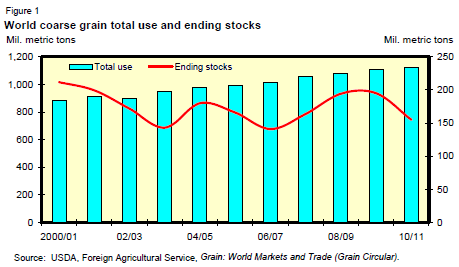
DOMESTIC OUTLOOK
2010/11 Feed Grain Supplies and Use Essentially Unchanged This Month
US feed grain supplies for 2010/11 remain at 380.3 million metric tons this month, unchanged from last month’s projection but down 4.4 per cent from last year. Total use of the four feed grains is nearly unchanged this month at 359.5 million metric tons. With demand exceeding supply, ending stocks are expected to be drawn down to 20.8 million metric tons, the lowest level since the end of the 1995/96 marketing year.The midpoint of the projected range for the 2010/11 corn price received by farmers remains at $5.40 a bushel this month, but both the lower and upper end of the range are reduced by 10 cents, to $5.15-$5.65 a bushel. With the exception of last month, corn prices at the farm gate have been below $5.00 a bushel so far this year. If the preliminary February price of $5.66 a bushel is confirmed, this will be the first time since September 2008 that prices at the farm gate have exceeded $5.00.
Feed and residual use for the four feed grains plus wheat on a September-August marketing year basis is unchanged this month, remaining at 142.7 million metric tons. Grain-consuming animal units (GCAU’s) are projected at 93.3 million this month, up slightly from last month's 93.1 million due to an increase in broiler production. The broiler production increase largely reflects relatively heavy bird weights, but the increase in forecast turkey production reflects higher poult placements as well as increased bird weights. Feed and residual use per animal unit is unchanged this month at 1.53 tons, which is down from 1.54 tons in 2009/10.
Minor Changes Made to Feed Grain Price Projections
The midpoint of the projected range for the 2010/11 corn price received by farmers remains at $5.40 a bushel this month, but both the lower and upper end of the range are reduced by 10 cents, to $5.15-$5.65 a bushel. With the exception of last month, corn prices at the farm gate have been below $5.00 a bushel so far this year. If the preliminary February price of $5.66 a bushel is confirmed, this will be the first time since September 2008 that prices at the farm gate have exceeded $5.00.
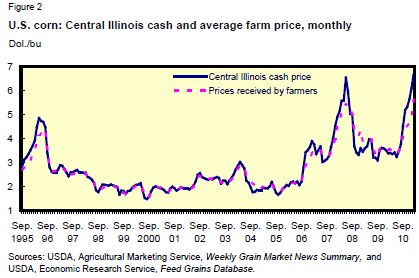
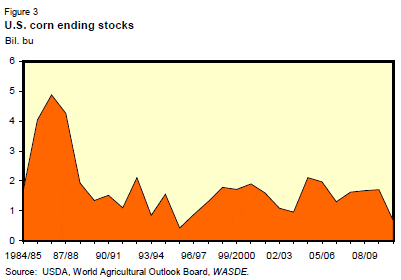
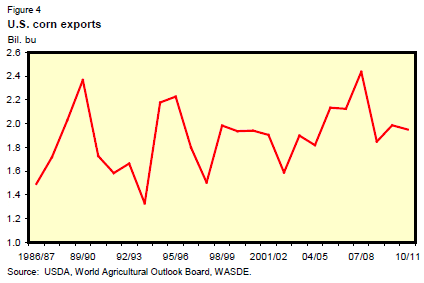
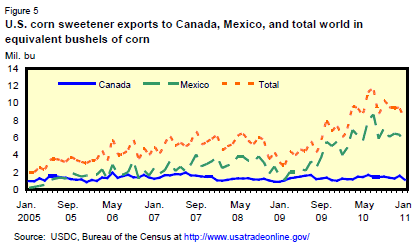
The farm price has been below prevailing cash market bids due to farmers forward contracting when prices were lower. Farm gate prices are expected to well exceed $6.00 per bushel in the coming months to reach the $5.40 midpoint of the projected season average price range.
The projected sorghum price received by farmers is lowered by 20 cents at the top end of the range, to $5.15-$5.65 a bushel. This lowered the midpoint by 10 cents to $5.40 per bushel, reflecting year-to-date price data. The barley and oat price estimates were also changed slightly this month, reflecting year-to-date data. The barley farm price projection is reduced by 10 cents and now stands at $3.70-$3.90 per bushel. The oat farm price projection is increased by 5 cents, to $2.35-$2.55 per bushel.
US barley exports for the 2010/11 crop year are lowered from 10 million bushels to 8 million bushels, reflecting shipments to date and minimal outstanding sales.
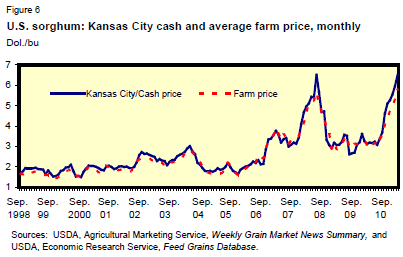

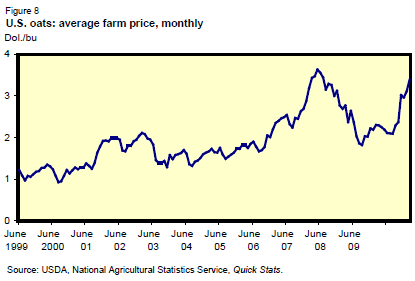
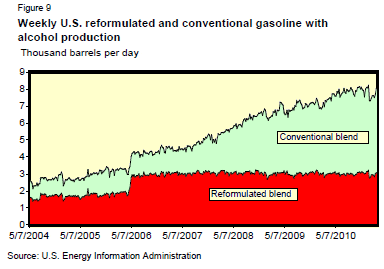
Ethanol Projection Unchanged
Corn used for fuel is unchanged. Recent lower weekly ethanol production and higher stock levels, according to Energy Information Administration data, are consistent with last month’s projection. Current ethanol production has returned to levels close to those prier to last December's increase. High petroleum and gasoline prices have reduced gasoline demand, lowering gasoline production. As ethanol blending nears practical limits, demand has deepened.
March Planting Intentions and Stocks Report are Keys to Price Prospects
Grain Stocks and Prospective Plantings are the key reports that will be released by the USDA’s National Agricultural Statistics Service on March 31, 2011. The stocks report will show grain stocks as of 1 March 2011. Stocks that are lower-thanexpected will imply greater feeding in the quarter ending 1 March and would be bullish for prices. A higher-than-expected stock level may moderate price increases somewhat.
At the 25 February 2011, USDA Outlook Conference, corn plantings this spring were projected at 92 million acres. Prices will likely respond if planted acreage is much different than this projection. In the past 20 years, the March projection was below the final acreage number 8 times and above it 12 times.
INTERNATIONAL OUTLOOK
World Coarse Grain Production Prospects for 2010/11 Reduced
Global coarse grain production for 2010/11 is projected down 1.8 million tons this month to 1,079.7 million. Reductions for Mexico, India, and Australia more than offset improved expectations for Brazil. World corn, barley, and sorghum production are each reduced 0.5 million tons, while global oats production is trimmed 0.3 million.
Mexico’s corn production for 2010/11 is cut 2.0 million tons to 22.0 million as an early February freeze devastated the crop in Sinaloa. The corn marketing year for Mexico is October-September, with about 75 per cent of the crop being produced in the main season (harvested in the fall). However, most of the winter-crop corn is grown in Sinaloa with irrigation. An exceptional freeze hit in the first week of February, with about 80 per cent of the corn planted. Satellite imagery verifies that much of the corn crop was killed. Some replanting will limit losses, but high temperatures later in the season will limit the window for replanting. Most of the Sinaloa corn is white corn destined for products for human consumption, such as tortillas.
India’s coarse grain production is cut 1.3 million tons to 40.4 million based on more complete harvest reports covering the last monsoon season. Sorghum area harvested came in 4 per cent below previous expectations, with average yields trimmed slightly more, cutting production 0.7 million tons to 6.8 million. Corn area was reported higher than expected, but yields were lower leaving production reduced 0.5 million tons to 20.5 million. Millet production is trimmed 0.1 million tons, but barley is increased 0.05 million.
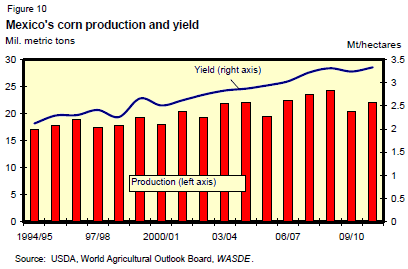
Australia’s coarse grain production is reduced 0.5 million tons this month to 13.4 million. More complete harvest reports indicate lower barley yields, cutting production 0.5 million tons to 9.3 million. Oats area and yields are reduced, cutting production 0.25 million tons to 1.5 million, but excellent sorghum yield prospects boost projected production 0.25 million tons to 2.2 million. Ukraine oats production is trimmed as lower area more than offset good reported yields. Also, Moldova’s 2010/11 coarse grain production is reduced slightly with a decline in barley more than offsetting a small increase in corn.
Brazil’s corn production prospects are increased 2.0 million tons this month to 53.0 million. Brazil’s Ministry of Agriculture reported excellent yields for the mainseason corn crop now being harvested. While the second-crop corn planted following short-season soybeans has been delayed by slow soybean harvesting, especially in Mato Grosso, the Government has extended the permitted planting window, supporting area prospects. However, late planted second-crop corn in Mato Grosso is more susceptible to an early end of the wet season, potentially limiting production prospects.
World coarse grain beginning stocks for 2010/11 are reduced this month by 0.7 million tons to 195.1 million. The largest reduction is for Brazil, with corn beginning stocks cut 0.4 million tons to 10.1 million due to stronger-than-expected exports during the March-February 2009/10 local marketing year (just ending). India’s coarse grain beginning stocks are down 0.1 million tons, mostly because of strong corn feed use and exports in 2009/10, partly offset by increased millet stocks. Saudi Arabia’s beginning stocks for 2010/11 are down 0.1 million this month as 2009/10 trade data show barley imports fell short of previous expectations. There are also small reductions in corn beginning stocks this month for Kenya and Taiwan.
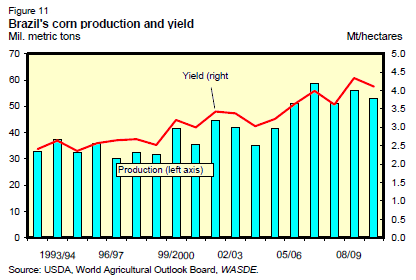
Global Use of Coarse Grains Reduced for 2010/11
Total world coarse grain use in 2010/11 is projected down 3.3 million tons this month to 1,119.9 million. Feed use is forecast up 0.3 million tons, but food, seed, and industrial use is down. Trade changes contribute heavily to the projected decline in global use.
Projected EU coarse grain total use is up 1.2 million tons this month with increases of 1.0 million tons for corn and 0.2 million for sorghum. Import licenses are up as prices in the EU encourage imports. Ukraine’s total coarse grain use is up 0.5 million tons, with feed use up 0.4 million as the slow pace of barley exports and uncertainty about export licenses is expected to encourage domestic use. Corn feed use prospects are increased slightly for Moldova.
Coarse grain feed use prospects are cut 0.9 million tons for Russia as the grain export ban has kept internal prices low, especially for low-quality wheat, discouraging imports and feeding of corn (down 0.5 million tons) and barley (down 0.4 million). Australia’s feed use is trimmed 0.4 million tons, with lower barley and oats production more than offsetting increased sorghum. There is also a small reduction in corn feed use prospects this month for Taiwan.
India’s coarse grain total use is down 1.3 million tons this month to 37.6 million. Lower production of sorghum, corn, and millet is expected to cut human consumption, with a reduction in projected sorghum feed use of 0.2 million tons. Food use is also cut this month for Mexican corn (down 0.3 million tons), Kenyan corn (down 0.1 million), and Chinese barley (trimmed 0.1 million).
Local marketing year trade changes can alter global use (see last month’s write up). With the sum of local marketing year coarse grain exports reduced 1.1 million tons this month, while the sum of imports are increased 0.9 million tons, the trade changes combine to reduce global coarse grain use by 2.0 million tons.
World Ending Stocks Projected Higher
Projected 2010/11 coarse grain use is cut more this month than supply, boosting forecast global ending stocks 0.8 million tons to 154.9 million. World corn ending stocks are up 0.6 million tons to 123.1 million. Global barley and millet stocks are up slightly while sorghum and oats prospects are trimmed.
The largest increase in projected 2010/11 ending stocks is a 1.6-million ton-increase for corn in Brazil to 8.8 million tons. Increased production is only partly offset by reduced beginning stocks, and forecast use (on a local marketing year) is unchanged. Brazil’s 2010/11 ending stocks are still projected lower than beginning stocks, but the tightening of stocks is not as great as projected a month ago. Other increases in projected ending stocks include a 0.3-million-ton increase in barley for both the EU and Ukraine, as well as small increases for US barley and Taiwan corn.
Partly offsetting the 2010/11 increased ending stocks expected for Brazil and others this month are several countries with reduced expected ending stocks. Mexico’s corn stocks are reduced 0.4 million tons to 1.5 million due to the cut in production. Australia’s coarse grain ending stocks are reduced 0.4 million tons this month, with reductions for barley and sorghum. Saudi Arabia’s coarse grain ending stock prospects are down 0.3 million tons with a decline for barley more than offsetting a small increase for corn. Ending stocks for corn in Kenya are down 0.2 million tons due to reduced imports. There are also small reductions this month for barley in China, corn in Moldova, and coarse grains in India, where a reduction for corn is almost offset by increases for millet, sorghum, and barley.
World Corn Trade Boosted Slightly, US Export Prospects Unchanged
Global corn trade for 2010/11 is forecast up 0.8 million tons this month to 92.1 million. Imports for Mexico are up 1.1 million tons to 9.0 million due to the production shortfall. EU imports are boosted 1.0 million tons to 6.5 million as import licenses are large and domestic prices encourage imports. Saudi Arabia’s corn import prospects are increased 0.1 million tons to 1.9 million, reflecting higher imports and feed use revealed by the latest estimates for 2009/10. However, corn imports for Russia are cut 0.5 million tons to 0.5 million as grain prices in Russia have not been high enough to encourage imports and no significant corn imports have occurred yet. Kenya’s corn imports are trimmed 0.25 million tons due to sufficient domestic supplies and lower estimated 2009/10 corn imports than previously forecast.
Brazil’s 2010/11 October-September corn exports are increased 1.0 million tons to a record 10.0 million. The shipment pace from October 2010 to February 2011 has been very rapid, at about 7.5 million tons, but is expected to slow dramatically as port capacity is switched to exporting soybeans, a more valuable crop. The availability or lack of government transport subsidies to move corn from the interior to the coast tends to accentuate the “lumpiness” of Brazilian corn exports.
Mexico, with reduced corn production, is expected to export 0.2 million tons less corn, leaving projected 2010/11 exports at only 0.1 million. Kenya’s corn exports are also reduced slightly.
US corn exports for 2010/11 are unchanged this month at 50.0 million tons (1.95 billion bushels for the September-August local marketing year). The forecast is nearly the same as the 49.9 million tons shipped the previous year. Census data for October-January indicate shipments of 14.0 million tons, virtually the same as a year earlier. However, grain inspections for February were 0.5 million tons less than those reported a year ago. The recent slow shipment pace is expected to increase as outstanding sales as of March 3, 2011, reached 12.8 million tons, up 2.3 million from a year earlier and the third highest for early March in the last 20 years.
World barley trade projected for 2010/11 is reduced 1.1 million tons this month to 16.0 million. Saudi Arabia’s barley imports are cut 0.6 million tons to 6.7 million on the slow pace of purchases and the Government’s goal of reducing subsidies.
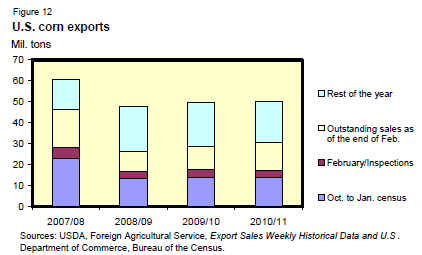
Imports by Russia and China are also reduced due to the slower-than-expected pace of purchases. The slow pace of sales and shipments supports a reduction in barley exports of 0.8 million tons for Ukraine, and 0.3 million for the EU. US barley exports are reduced for the local June-May marketing year but unchanged for the October-September trade year.
Global sorghum trade for 2010/11 is increased slightly with 0.2-million-ton increases for Australia’s exports and EU imports. US sorghum export prospects are unchanged this month at 3.8 million tons. The pace of exports for the first 5 months of the trade year has been sluggish, but at the beginning of March 2011, outstanding export sales are up 21 per cent from a year ago.
Further Reading
| - | You can view the full report by clicking here. |
March 2011


